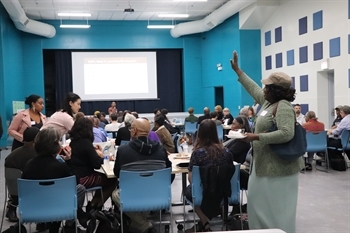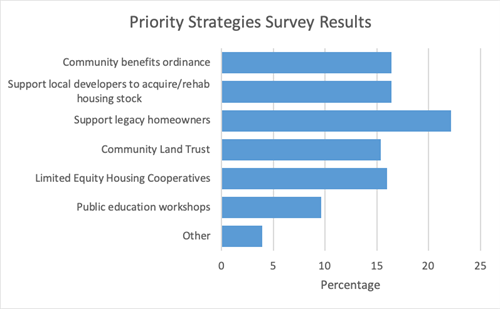East Garfield Park residents gather to discuss goals and strategies for preserving affordability and preventing displacement in a community-driven planning process piloted by MPC, Institute of Housing Studies, and Garfield Park Community Council.

Neighborhood residents discuss housing strategies in small groups.
Liz Granger, Metropolitan Planning Council
 By Jane Anderson, Research Assistant; Edited by: Juan Sebastian Arias, Manager
By Jane Anderson, Research Assistant; Edited by: Juan Sebastian Arias, Manager - November 13, 2019
Over the last few years, East Garfield Park has seen an increase in new development and investment, with property prices quadrupling over the past six years. Between 2012 and 2018 the median sale price for one-to-four unit properties increased from $40,000 to $160,000. While many residents acknowledge that investment is needed to support their community, oftentimes, long-time residents do not reap the benefits and risk displacement. So how can communities have new development and investment, while also ensuring that long-time, legacy residents do not get displaced as a result?
A blueprint for a brighter future
This summer, the Metropolitan Planning Council, Garfield Park Community Council and the Institute of Housing Studies (IHS) at DePaul University launched a pilot program to explore this exact issue. The Preserving Affordability Together (PAT) process equips community members with the tools to prevent displacement and ensure that existing residents benefit from new investment.
We hosted a first community meeting for this process in July. Since then, local residents and stakeholders came together in a Working Group to develop recommendations for preserving affordability in East Garfield Park. Over the course of two meetings, the Working Group used data and community input to develop a community-driven mission statement, vision statement, and seven goals.
Second community meeting hosted in October

Liz Granger, Metropolitan Planning Council
Over 80 people came together at our second community to hear updates on progress made so far and prioritize housing strategies to preserve affordability. Almost 50% of attendees were long-time residents (defined as having lived in the neighborhood over 20 years). Over 50% of attendees also identified as African American.
Long-time resident and local pastor Reverend Dr. Walter A. McCray kicked off the meeting by providing background context to the project as well as delivering an encouraging and uplifting speech on why it is critical to take action to preserve affordability in East Garfield Park. Then, working group members presented the vision statement, mission statement, and goals, which are meant to guide the strategies in the final report.
Next, MPC manager Juan Sebastian Arias dug into potential priority strategies identified through a mix of local lived experience, affordable housing research, and policy best practice. Through an informal poll, participants were asked to rank their top three priority strategies. Results showed that their number one priority is to support legacy homeowners stay in place, followed by supporting local developers to acquire and rehab housing stock, developing and passing a community benefits ordinance, and developing Limited Equity Housing Cooperatives as affordable ownership opportunities for low-income residents.

Participants also received one of the first deliverables from this project: an infographic “cheat sheet” put together by MPC and IHS providing data and statistics on housing conditions and displacement pressures in Garfield Park. The one-pager will function as an advocacy and messaging tool for residents, policymakers and community leaders.
Let’s talk. Small groups discuss strategies
Participants then broke in to seven groups to discuss these strategies. They were asked three main questions: What can community groups do? What can government do? And, what can the private sector do? The discussions yielded some valuable insights:
Community Groups
One topic that frequently came up in discussion is the need for a strengthened sense of community. Kyle Warner, long-time resident, community activist and pastor, emphasized that there needs to be an understanding that the legacy and new community residents have to come together.
“Ninety-five percent of our power is anchored in city hall,” said Warner. “We need the power to be anchored from community residents. We know what’s best for us. Residents have to come together—we need this community coalition to come together to act as a governing table”. A formal coalition is one way to achieve this. However, participants also believed that having some anchor group or committee to plan fun community events that would attract the community to come together would also help build and strengthen a cohesive community.
Government

Liz Granger, Metropolitan Planning Council
In terms of the government’s role, participants would like to see more of a presence and transparency from local government on what policies are being implemented in their community.
As reflected in the poll, participants emphasized the importance of a neighborhood-level (and even City-wide) community benefits ordinance. A community benefits ordinance could help enforce strategies that would make private entities, such as developers, follow these agreements. However, many participants expressed that government and Aldermanic support is essential to make this work.
Private Sector
In terms of what the private sector can do to help preserve affordability in East Garfield Park, participants would like to see increased support for small businesses. This may look like establishing a local business hub or funds that specifically support locally owned businesses.
Another role for the private sector is in supporting education programs. Hector Juarez, property owner and long-time East Garfield Park resident, emphasized the importance of having accessible home repair programs. These programs exist, he says, but people don’t really know about them. “We need to push out these programs to repair their homes, even if it’s just fixing the outside of the house. If you see a neighborhood doing good, others will want to too”.
A new community coalition is formed
The meeting concluded with Steven Stultz, East Garfield Park resident and founder of Nu-Church Apostolic Ministries, announcing the formation of a new community coalition. The need to form a strong local coalition was identified early on by local leaders as a foundational priority for preserving affordability in the neighborhood.
The coalition will build community power by bringing together diverse stakeholders in East Garfield Park under a common vision. As the coalition formalizes over the next few months, members will use the PAT goals and recommendations to finalize, implement, and enforce an affordability and stability plan, as well as perform Census count outreach and voter registration.
What's next?
In the coming months, MPC and partners will be producing a community-driven report, supporting the creation of a local coalition, and helping implement recommendations. The project will conclude with a community celebration of the published report and action plan, as well as the hard work, commitment and efforts of those involved in making this plan a reality.
Please contact Juan Sebastian Arias at jsarias@metroplanning.org if you are interested in joining the effort to preserve affordability in East Garfield Park.